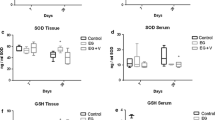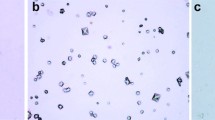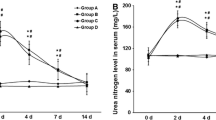Abstract
This study aimed at evaluating the protective effects of a herbal medication (Tutukon) on the hyperoxaluria induced apoptotic changes and crystal deposition in renal tubular epithelium in rat model. 60 male wistar rats were divided into three different groups (each group n: 20). In Group I severe hyperoxaluria was induced by ethylene glycol (EG) (0.75 %) administration for 28 days. In Group II, in addition to hyperoxaluria induction, animals were treated with Tutukon for 28 days. Group III animals constituted the controls without any specific medication and/or intervention. While the presence and degree of crystal deposition in the tubular lumen were examined histopathologically under light microscopy, tubular apoptotic changes were evaluated using immunohistochemical staining for cysteine-aspartic acid protease-3 (Caspase-3) and tumor necrosis factor alpha (TNF-α) positivity on days 14 and 28, respectively. Evaluation of apoptotic changes by Caspase-3 positivity showed that while the majority of animals undergoing EG only showed evident apoptotic changes (n: 9), Tutukon application demonstrated a significant limitation with limited or no apoptosis (n: 7) in these animals. Similar data were noted for TNF alpha expression; while apoptotic changes were evident in 8 (80 %) in Group I animals, limited changes were noted in Tutukon Group (n: 2). Regarding crystal deposition despite evident changes in Group I (9 animals), like apoptotic alterations, it was again significantly limited in animals receiving Tutukon (4 animals). Renal tubular crystal deposition and apoptotic changes induced by hyperoxaluria play a role in the pathogenesis of urolithiasis and the limitation of these changes might be instituted by Tutukon as a result of its antioxidant and antiinflammatory effects.






Similar content being viewed by others
References
Hackett RL, Shevock PN, Khan SR (1990) Cell injury associated with calcium oxalate crystalluria. J Urol 144:1535
Khan SR, Shevock PN, Hackett RL (1989) Urinary enzymes and calcium oxalate urolithiasis. J Urol 142:846
Lieske JC, Norris R, Swift H, Toback FG (1997) Adhesion, internalization and metabolism of calcium oxalate monohydrate crystals by renal epithelial cells. Kidney Int 52:1291
Koul H, Kennington L, Nair G, Honeyman T, Menon M, Scheid C (1994) Oxalate-induced initiation of DNA synthesis in LLC-PK1 cells, a line of renal epithelial cells. Biochem Biophys Res Commun 205:1632
Scheid CR, Koul H, Hill WA, Luber-Narod J, Jonassen J, Honeyman T, Kennington L, Kohli R, Hodapp J, Ayvazian P, Menon M (1996) Oxalate toxicity in in LLC-PK1 cells, a line of renal epithelial cells. J Urol 155:1112
Scheid CR, Koul H, Kennington L, Hill WA, Luber-Narod J, Jonassen J, Honeyman T, Menon M (1995) Oxalate-induced damage to renal tubular cells. Scanning Microsc 9:1097
Selvam R, Bijikurien T (1992) Effect of citrate feeding on free radical induced changes in experimental urolithiasis. Indian J Exp Biol 30:705
Strohmaier WL, Bichler KH, Koch J, Balk KN, Wilbert DM (1993) Protective effect of verapamil on shock wave-induced renal tubular dysfunction. J Urol 150:27
Sarıca K, Kupeli B, Budak M, Kosar A, Kavukcu M, Durak I, Gogus O (1997) Influence of experimental spermatic cord torsion on the contralateral testes in rats: evaluation of tissue free oxygen scavenger enzyme levels. Urol Int 58:208
Scheid C, Koul H, Hill WA, Luber-Narod J, Kennington L, Honeyman T, Jonassen J, Menon M (1996) Oxalate toxicity in LLC-PK1 cells: role of free radicals. Kidney Int 49:413
Benyi L, Weilherg Z, Puyun L (1995) Protective effects of nifedipine and allopurinol on high energy shock wave induced acute changes of renal function. J Urol 153:596
Sarıca K, Bakır K, Yagcı F, Topcu O, Akbay C, Sayın N, Korkmaz C (1999) Limitation of possible enhanced crystal deposition by verapamil in renal parenchyma after shock wave application in rabbit model. J Endourol 13:343
Cohen PJ (1992) Allopurinol administered prior to hepatic ischemia in the rat prevents chemiluminescence following restoration of circulation. Can J Anesth 39:1090
Parekh MH, Lobel R, O’Connor L, Leggett RE, Levin RM (2001) Protective effect of Vitamin E on the response of the rabbit bladder to partial outlet obstruction. J Urol 166:341
Khan SR (1995) Calcium oxalate crystal interaction with renaltubular epithelium, mechanism of crystal adhesion and its impact on stone development. Urol Res 23:71
Khan SR, Shevock PN, Hackett RL (1992) Acute hyperoxaluria, renal injury and calcium oxalate urolithiasis. J Urol 147:226
Sarıca K, Yagcı F, Bakır K, Erturhan S, Ucak R (2001) Renal tubular injury induced by hyperoxaluria: evaluation of apoptotic changes. Urol Res 29:34
Ogawa Y, Yamaguchi K, Morozumi M (1990) Effects of magnesium salts in preventing experimental oxalate urolithiasis. J Urol 144:385
Sarıca K, Bakır K, Yagcı F, Erbagcı A, Topcu O, Uysal O (2000) Unilateral testicular torsion; protective effect of verapamil on contralateral testicular histology. Urol Int 62:159
Sarıca K, Ozer G, Soygur T, Yaman O, Ozer E, Ustun H, Yaman LS, Gogus O (1997) Preservation of shock-wave-induced renal histologic changes by Dermatan sulphate. Urology 49:145
Sarıca K, Kosar A, Yaman O, Beduk Y, Durak I, Gogus O, Kavukcu M (1996) Evaluation of ischemia after ESWL: detection of free oxygen radical scavenger enzymes in renal parenchyma subjected to high energy shock waves. Urol Int 57:221
Itoh Y, Yasui T, Okada A, Tozawa K, Hayashi Y, Kohri K (2005) Preventive effects of green tea on renal stone formation and the role of oxidative stress in nephrolithiasis. J Urol 173(1):271–275
Cho Hyuk Jin, Bae Woong Jin, Kim Su Jin, Hong Sung Hoo, Lee Ji Youl, Hwang Tae-Kon, Choi Yeong Jin, Hwang Sung Yeoun, Kim Sae Woong (2014) The inhibitory effect of an ethanol extract of the spores of Lygodium japonicum on ethylene glycol-induced kidney calculi in rats. Urolithiasis 42(4):309–315
Butterweck V, Khan SR (2009) Herbal medicines in the management of urolithiasis: alternative or complementary? Planta Med 75(10):1095–1103
Calixto JB, Santos AR, Cechinel Filho V et al (1998) A review of the plants of the genus Phyllanthus: their chemistry, pharmacology, and therapeutic potential. Med Res Rev 18:225
Calixto JB, Yunes RA, Neto AS et al (1984) Antispasmodic effects of an alkaloid extracted from Phyllanthus sellowianus: a comparative study with papaverine. Braz J Med Biol Res 17:313
Zadra M, Piana M, Brum TF, Boligon AA, Freitas RB, Machado MM, Stefanello ST, Soares FA, Athayde ML (2012) Antioxidant Activity and phytochemical composition of the leaves of Solanum guaraniticum A. St.-Hil. Molecules 17(11):12560–12574
Wang H, Yang L, Zu Y, Zhao X (2014) Microwave-assisted simultaneous extraction of luteolin and apigenin from tree peony pod and evaluation of its antioxidant activity. Sci World J 2014:506971
Xi M, Hai C, Tang H, Chen M, Fang K, Liang X (2008) Antioxidant and antiglycation properties of total saponins extracted from traditional Chinese medicine used to treat diabetes mellitus. Phytother Res 22(2):228–237
Atmani F, Slimani Y, Mimouni M et al (2004) Effect of aqueous extract from Herniaria hirsuta L. On experimentally nephrolithiasic rats. J Ethnopharmacol 95:87
Nishiura JL, Campos AH, Boim MA et al (2004) Phyllanthus niruri normalizes elevated urinary calcium levels in calcium stone forming (CSF) patients. Urol Res 32:362
Ariffin A, Rahman NA, Yehye WA, Alhadi AA (2014) Kadir FA:PASS-assisted design, synthesis and antioxidant evaluation of new butylated hydroxytoluene derivatives. Eur J Med Chem 2(87C):564–577
Bodakhe KS, Namdeo KP, Patra KC, Machwal L, Pareta SK (2013) A polyherbal formulation attenuates hyperoxaluria-induced oxidative stress and prevents subsequent deposition of calcium oxalate crystals and renal cell injury in rat kidneys. Chin J Nat Med 11(5):466–471
Conflict of interest
We have no conflict of interest.
Author information
Authors and Affiliations
Corresponding author
Rights and permissions
About this article
Cite this article
Sahin, C., Sarikaya, S., Basak, K. et al. Limitation of apoptotic changes and crystal deposition by Tutukon following hyperoxaluria-induced tubular cell injury in rat model. Urolithiasis 43, 313–322 (2015). https://doi.org/10.1007/s00240-015-0777-1
Received:
Accepted:
Published:
Issue Date:
DOI: https://doi.org/10.1007/s00240-015-0777-1




